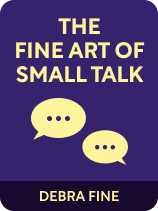

This article is an excerpt from the Shortform book guide to "The Fine Art of Small Talk" by Debra Fine. Shortform has the world's best summaries and analyses of books you should be reading.
Like this article? Sign up for a free trial here .
Do you struggle to make personal connections with others? What does acceptance have to do with connection?
Whether it’s with a friend or with a date, making connections is important. There are several ways you can go about doing this, but the root of all connections is acceptance.
Keep reading to learn how to make personal connections.
Making Connections
Fine emphasizes that your goal when conversing with a date isn’t just to talk; it’s to connect. As such, don’t plan your next question as your partner is answering your first—listen to them and think about their answer. Follow up by commenting on their response, prompting them to tell you more, or sharing something about yourself that’s connected to what they’ve just said.
(Shortform note: This formula builds a personal connection by allowing both parties to seek commonality, explore shared interests, and learn about each other. The ask, listen, explore loop helps you find topics you can both enjoy discussing more deeply.)
Whenever your date doesn’t give you enough to follow up on, use one of your icebreakers—the questions you prepared by exploring the venue, researching the event, or reading their profile.
Acceptance Is the Root of Deep Connection
For singles, making a personal connection is even more critical than Fine describes because the lack of it creates loneliness. Often, loneliness in singles comes from the fact that nobody sees them being truly relaxed and “human”—their unfiltered “self” isn’t known, accepted, and loved, since they have nobody to share it with. They need to share the unpolished being that wakes up groggy when their alarm rings, and they need it to be as appreciated and valued as their clean, professional, and put-together facade. Here’s how to use conversation to deepen a connection and increase the chances that someone gets to know your true, unfiltered self:
Ask deep, personal, or emotional questions unapologetically and answer them openly. Adopt the mindset that discussing emotional topics is normal and acceptable—bonding over such topics is what creates deeper connections. Be willing to show your partner they’re safe by being the first to be vulnerable.
Encourage openness by refusing to judge anything about the other person. The primary reason we avoid sharing with others is that we fear judgment and rejection. Many of us are so used to being attacked or put down when we share that we clam up at the slightest hint of disapproval. But when you intentionally judge nothing, you give others the safety they need to share who they are at their deepest level.
Accept without fixing or dismissing. Understand that people share to connect—not to ask for help or seek opinions. If your partner says, “I don’t travel much because I’m afraid of flying,” she’s not asking you to point out that her fear is irrational or to explain how to get over it. Accept that fear, acknowledge that it’s real, and let her tell you what it’s like to live with it. That’s how you get to know more about her.
Relate by sharing emotionally similar experiences. This deepens the connection by showing your partner you understand them—and that you’re willing to join them in being vulnerable. It’s critical to relate to the emotion connected to the topic, not its context. In the above example, the correct move is to share an irrational fear of your own—one that makes you feel the way she described feeling herself. The wrong move would be to discuss flying or travel in general.

———End of Preview———
Like what you just read? Read the rest of the world's best book summary and analysis of Debra Fine's "The Fine Art of Small Talk" at Shortform .
Here's what you'll find in our full The Fine Art of Small Talk summary :
- Why we need small talk and why we shouldn't avoid it
- How to appear confident and engaging in any context
- How to break the ice with strangers and keep the conversation going






